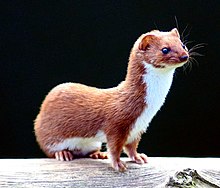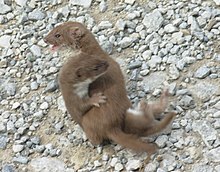Least weasel
| Least weasel Temporal range: Late Pleistocene–Recent
| |
|---|---|

| |
| Least weasel at the British Wildlife Centre, Surrey, England | |
| Scientific classification | |
| Domain: | Eukaryota |
| Kingdom: | Animalia |
| Phylum: | Chordata |
| Class: | Mammalia |
| Order: | Carnivora |
| Family: | Mustelidae |
| Genus: | Mustela |
| Species: | M. nivalis
|
| Binomial name | |
| Mustela nivalis | |

| |
| Global range of M. nivalis | |
The least weasel (Mustela nivalis) is the world's smallest mammalian carnivore. It is the smallest member of the genus Mustela, the smallest member of the family Mustelidae and the order Carnivora.[2][3] It is also called the little weasel or common weasel.[4]
The weasel is native to Eurasia, North America and North Africa. It has been introduced to New Zealand, Malta, Crete, Bermuda, Madeira Island, the Azores, the Canary Islands, São Tomé, the Falkland Islands, Argentina and Chile. It is a least concern species.
Description[change | change source]

The least weasel has a thin, long and very flexible body. It has a small, long, head. The legs and tail are short. The feet have sharp, dark-coloured claws and a lot of hairs on the bottom.[5] Its eyes are small when compared to their head size. Its eyes are dark colored.
The legs and tail are relatively short. The tail makes up less than half the body length.[6]
Males have an average length of 130 to 260 millimetres (5 to 10 inches) long. Females have an average length of 114 to 204 millimetres (4.5 to 8.0 inches) long. Males weigh 36 to 250 grams (1.3 to 8.8 ounces). Females weigh 29 to 117 grams (1.0 to 4.1 ounces).
Territorial and social behaviour[change | change source]

Male least weasels have territories that include many female territories. The number of least weasels in each territory depends on the amount of food and reproductive success. The male least weasel has a bigger territory during spring or when there is less food.[7] It uses faeces and urine to mark its territory. The least weasel does not dig its own den, but stays in the burrows that other animals have left, like a mole or rat.[8]
Breeding[change | change source]
The least weasel mates from April to July. The gestation period is 34 to 37 days. In the Northern Hemisphere, the least weasel usually give birth to 6 kits. Kit is the name for baby weasels. The least weasel is able to reproduce by the age of three to four months.
The female takes care of its kits without help from the male. The kits weigh 1.5 to 4.5 grams (0.05 to 0.16 ounces). Newborn kits are born pink, naked, blind and deaf. They will have a white coat of downy fur at the age of four days. The first teeth come out at the age of two to three weeks. They start to eat solid food at that time.
The eyes and ears open at the age of at three to four weeks. By eight weeks they learn how to kill the animals that they eat. The young ones leave the family after nine to twelve weeks. Least weasels can live for seven or eight years.[9]
Feeding[change | change source]

The least weasel mostly eats rodents, for example mice, hamsters, and gerbils. It usually does not attack adult hamsters and rats. Frogs, fish, small birds and bird eggs are almost never eaten. It can attack adult pikas and gerbils. Least weasels sometimes kill prey larger than themselves, such as capercaillie, hazel grouse and hares. In England, the least weasel likes to eat the field vole.[10]
Even though it is small, the least weasel is a great hunter. It is able to kill a rabbit five to 10 times its own weight. Even though they are commonly eaten, the rabbits are usually young ones. Rabbits become a very important source of food during the spring, when there are few small rodents.[3]
Predators[change | change source]
Red foxes, sables, steppe and forest polecats, stoats, eagle owls and buzzards are predators of the least weasel. Owls are very good at catching least weasels. Some of the owls that hunt least weasels include barn owls, barred owls, and great horned owls. Other birds of prey that eat the least weasel include broad-winged buzzards and rough-legged buzzards. Some types of snake may eat the least weasel. They include the black rat snake and the copperhead.[11]
Disease and parasites[change | change source]
Ectoparasites also target weasels. Common ones are different species of lice, mites and fleas. Very often, weasels get the parasites from the nests or burrows of their prey. Certain species of nematode also infect weasels.[12]
Distribution[change | change source]

The least weasel lives in Europe, North Africa, Asia and parts of northern North America. It mostly lives in places where there are no stoats. It has become extinct from New York City. It has been introduced in New Zealand, Malta, Crete, the Azore Islands and São Tomé off West Africa. It is found throughout Europe (but not Ireland). It is also found on many islands, including the Azores, Great Britain, and all major Mediterranean islands. It also lives in Honshū and Hokkaidō Islands in Japan and on Kunashir, Iturup, and Sakhalin Islands in Russia.[6][13][14]
The least weasel can be found in fields, open woodland, bushy or rocky places, parks and gardens. It can be found at altitudes of up to about 3,000 metres (9,800 feet).[9]
Conservation status[change | change source]
The least weasel is listed as a least concern species by the International Union for Conservation of Nature. It has a very large range and a large total population. It is common in Eurasia but less abundant in North America. It is thought to be rare in the southeastern United States.[15]
References[change | change source]
- ↑ McDonald, R.A., Abramov, A.V., Stubbe, M., Herrero, J., Maran, T., Tikhonov, A., Cavallini, P., Kranz, A., Giannatos, G., Kryštufek, B. & Reid, F. (2019). Mustela nivalis (amended version of 2016 assessment). The IUCN Red List of Threatened Species 2019. doi:10.2305/IUCN.UK.2016-1.RLTS.T70207409A147993366.en
- ↑ Van Valkenburgh, Blaire; Wayne, Robert K. (2010). "Carnivores". Current Biology. 20 (21): R915–R919. doi:10.1016/j.cub.2010.09.013. PMID 21056828. S2CID 235312150.
- ↑ 3.0 3.1 "Stoat and weasel guide: how to identify, habitat, diet and best places to spot". Discover Wildlife. Retrieved 2020-08-30.
- ↑ Shorter Oxford English dictionary on historical principles. Stevenson, Angus., Brown, Lesley. (6th ed.). Oxford: Oxford University Press. 2007. ISBN 978-0-19-920687-2. OCLC 170973920.
{{cite book}}: CS1 maint: others (link) - ↑ Fergus, Chuck. Weasels (PDF).
- ↑ 6.0 6.1 Long, John L. (2003). Introduced Mammals of the World : Their History, Distribution and Influence. Melbourne: CSIRO Pub. ISBN 978-0-643-09015-6. OCLC 476021923.
- ↑ Erlinge, S. (1974). "Distribution, Territoriality and Numbers of the Weasel Mustela nivalis in Relation to Prey Abundance". Oikos. 25 (3): 308–314. doi:10.2307/3543948. JSTOR 3543948.
- ↑ Mammals of the British Isles : handbook. Stephen Harris, D. W. Yalden, Mammal Society (4th ed.). Southampton: Mammal Society. 2008. ISBN 978-0-906282-65-6. OCLC 231001892.
{{cite book}}: CS1 maint: others (link) - ↑ 9.0 9.1 Koenig, Klaus. (1973). Mammals. Collins. ISBN 0-00-212080-1. OCLC 705415902.
- ↑ Tapper, Stephen (1979). "The Effect of Fluctuating Vole Numbers (Microtus agrestis) on a Population of Weasels (Mustela nivalis) on Farmland". The Journal of Animal Ecology. 48 (2): 603–617. doi:10.2307/4182. JSTOR 4182.
- ↑ "Mustela nivalis : Least Weasel | Rare Species Guide". Minnesota Department of Natural Resources. Retrieved 2021-05-12.
- ↑ King, Carolyn M. (2009-08-20). "The effects of the nematode parasite Skrjabingylus nasicola on British weasels (Mustela nivalis)". Journal of Zoology. 182 (2): 225–249. doi:10.1111/j.1469-7998.1977.tb04157.x.[permanent dead link]
- ↑ Rodrigues, Mónica; Bos, Arthur R.; Schembri, Patrick J.; de Lima, Ricardo F.; Lymberakis, Petros; Parpal, Lluís; Cento, Michele; Ruette, Sandrine; Ozkurt, Sakir O. (2016-12-10). "Erratum to: Origin and introduction history of the least weasel (Mustela nivalis) on Mediterranean and Atlantic islands inferred from genetic data". Biological Invasions. 19 (1): 423–424. doi:10.1007/s10530-016-1347-3. ISSN 1387-3547. S2CID 27764046.
- ↑ McDonald, R.A.; Abramov, A.V.; Stubbe, M.; Herrero, J.; Maran, T.; Tikhonov, A.; Cavallini, P.; Kranz, A.; Giannatos, G. (2015-05-02). "Mustela nivalis". doi:10.2305/iucn.uk.2016-1.rlts.t70207409a147993366.en.
{{cite journal}}: Cite journal requires|journal=(help) - ↑ McDonald, R.A., Stubbe, M., Maran, T., Giannatos, G., B. & Reid, F., Abramov, A.V., Herrero, J., Tikhonov, A., Cavallini, P., Kranz, A. (2015-05-02). "Mustela nivalis". The IUCN Red List of Threatened Species 2019. doi:10.2305/iucn.uk.2016-1.rlts.t70207409a147993366.en.
{{cite journal}}: CS1 maint: multiple names: authors list (link)

